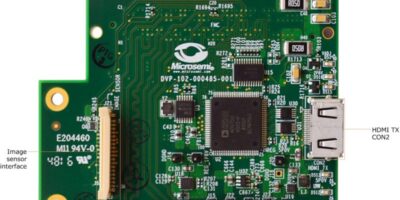Microsemi enhances imaging FPGAs for MIPI CSI-2 camera systems
Enhancements to Microsemi’s imaging/video FPGAs include a field programmable gate array (FPGA) mezzanine card (FMC) –based daughter card (pictured) and intellectual property (IP) to support images sensors with Mobile Industry Processor Interface (MIPI) Camera Serial Interface (CSI) -2 based camera systems.
The enhancements enable customers to use Microsemi’s power-efficient, secure IGLOO 2 FPGA and SmartFusion 2 system on chip (SoC) FPGA capabilities in CSI-2-based camera systems.
As a standard specification by the MIPI Alliance, MIPI CSI-2 defines an interface between a peripheral device, such as an image sensor, and a host processor, such as a baseband or application processor. Microsemi’s imaging and video combination comprises an imaging/video IP suite and FMC daughter card for MIPI CSI-2 sensor interface. Users can instantiate the MIPI CSI-2 IP in the SmartFusion2 or IGLOO 2 FPGA designs and then implement image processing and bridging to other interfaces or peripherals. By leveraging Microsemi’s power-efficient FPGAs in the designs of CSI-2 cameras, users could potentially lower system costs or use smaller, longer lasting batteries, says Microsemi, while benefitting from using secure FPGAs to protect IP.
The low power consumption of the IGLOO 2 and SmartFusion 2 FPGAs are beneficial for camera designs which are often size and power constrained, says the company. The enhancements expand Microsemi’s customer base for those designing with CSI-2 cameras across high security, low power applications, it says.
Microsemi’s MIPI CSI-2 imaging/video solution’s FMC-based daughter card has an image sensor module which works with Microsemi’s SmartFusion 2 advanced development kit. The MIPI CSI-2 receiver decoder IP is supported in SmartFusion 2 and IGLOO 2 FPGAs. There is also a MIPI CSI-2 reference design project and a graphical user interface (GUI) software for real-time video demonstration configuration. The company also expects future enhancements to its CSI-2 IP and FMC daughter card to support its recent cost-optimised, low power PolarFire mid-range FPGAs.
The MIPI CSI-2 receiver decoder IP supports multi-lane (one, two and four lanes), RAW8 (eight bit data width), and both short packet and long packet formats for transporting image data.
Designs can be reused across multiple platforms using Libero SoC Design Suite, a development toolset for designing with Microsemi’s FPGAs and SoC FPGAs.
Suitable image and video applications are in industrial, defence, medical, aviation and automotive markets, including machine vision cameras, thermal, infra red (IR) and night vision cameras, hand-held cameras and medical imaging. In applications such as thermal imaging, Microsemi believes that its low power dissipation can provide advantages over competing FPGAs and digital signal processors (DSPs).
Microsemi’s imaging/video IP suite, MIPI CSI-2 receiver decoder IP are available in the IP Catalog accessed from the Libero SoC software. The MIPI CSI-2 FMC-based daughter card is also available now.




